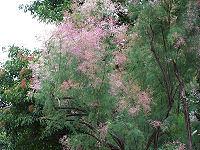
Nitrogen distribution as affected by stocking density in a combined production system of energy crops and free-range pigs
Sign Up to like & getrecommendations! Published in 2018 at "Agroforestry Systems"
DOI: 10.1007/s10457-018-0200-3
Abstract: Free-range pig production is typically associated with high risks of nitrogen (N) leaching due to the pigs excretory behaviour creating nitrogen ‘hotspots’ and rooting behaviour destroying the grass sward. This challenge is reinforced at high… read more here.
Keywords: free range; production; stocking density; density ... See more keywords

Energy Use Efficiency of Biogas Production Depended on Energy Crops, Nitrogen Fertilization Level, and Cutting System
Sign Up to like & getrecommendations! Published in 2020 at "BioEnergy Research"
DOI: 10.1007/s12155-020-10147-2
Abstract: The paper evaluates the relation between energy input (E i ) and output (E o ) of biogas production from six energy crops: maize, sorghum, sunflower, triticale, reed canary grass (RCG), and Virginia mallow (VM),… read more here.
Keywords: fertilization; biogas production; energy; nitrogen fertilization ... See more keywords

Green, Blue and Grey Bioenergy Water Footprints, a Comparison of Feedstocks for Bioenergy Supply in 2040
Sign Up to like & getrecommendations! Published in 2018 at "Environmental Processes"
DOI: 10.1007/s40710-018-0311-x
Abstract: Today, traditional biomass contributes 75% to total bioenergy use, but the share of modern biomass, e.g., for biofuels or electricity, increases. Bioenergy derives from first (food crops), second (energy crops or agricultural residues) and third… read more here.
Keywords: energy; water; energy crops; bioenergy supply ... See more keywords

Sweet sorghum and Miscanthus: Two potential dedicated bioenergy crops in China
Sign Up to like & getrecommendations! Published in 2017 at "Journal of Integrative Agriculture"
DOI: 10.1016/s2095-3119(15)61181-9
Abstract: Abstract Among the potential non-food energy crops, the sugar-rich C4 grass sweet sorghum and the biomass-rich Miscanthus are increasingly considered as two leading candidates. Here, we outline the biological traits of these energy crops for… read more here.
Keywords: sweet sorghum; miscanthus two; sorghum miscanthus; energy crops ... See more keywords

Assessment of liquid biofuel potential from energy crops within the sustainable water–land–energy–carbon nexus
Sign Up to like & getrecommendations! Published in 2021 at "Sustainable Energy and Fuels"
DOI: 10.1039/d0se00814a
Abstract: With the rapid development of biofuels, doubts about their sustainability have also been raised. To explore the answer to this question, researchers have paid considerable attention to the assessment of the benefits of biofuels, especially… read more here.
Keywords: sustainable water; energy; liquid biofuel; biofuel potential ... See more keywords

Transcriptomic characterization of candidate genes responsive to salt tolerance of Miscanthus energy crops
Sign Up to like & getrecommendations! Published in 2017 at "GCB Bioenergy"
DOI: 10.1111/gcbb.12413
Abstract: Given the growing need for biofuel production but the lack of suitable land for producing biomass feedstock, development of stress‐tolerant energy crops will be increasingly important. We used comparative transcriptomics to reveal differential responses to… read more here.
Keywords: five populations; salt; tolerance; stress ... See more keywords

Ammonia Volatilization from Fertilizer Urea—A New Challenge for Agriculture and Industry in View of Growing Global Demand for Food and Energy Crops
Sign Up to like & getrecommendations! Published in 2021 at "Agriculture"
DOI: 10.3390/agriculture11090822
Abstract: The growing world population and the necessity to meet its nutritional needs despite the limited area of agricultural land pose a serious challenge for agriculture. Agriculture is responsible for 80–95% of total ammonia emissions to… read more here.
Keywords: ammonia emissions; production; agriculture; energy crops ... See more keywords